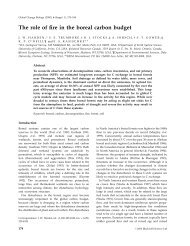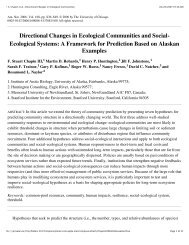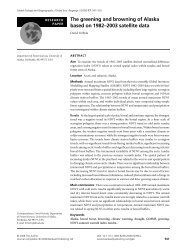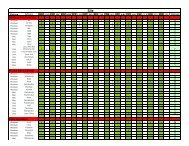Harden, J.W., K.L. Manies, J. O'Donnell, K. Johnson, S. Frolking, Z ...
Harden, J.W., K.L. Manies, J. O'Donnell, K. Johnson, S. Frolking, Z ...
Harden, J.W., K.L. Manies, J. O'Donnell, K. Johnson, S. Frolking, Z ...
Create successful ePaper yourself
Turn your PDF publications into a flip-book with our unique Google optimized e-Paper software.
G01012<br />
HARDEN ET AL.: C FATE IN BLACK SPRUCE FOREST SOILS<br />
G01012<br />
Figure 5. Net C balance based on (a) eddy covariance (Thompson only); (b) incremental soil stock<br />
change (all site combinations of all study areas from Table S3 in Text S1 of the auxiliary material), where<br />
the x axis error bars represent the range of the age class and y axis error bars are standard errors; and<br />
(c) from equation (3) (Thompson only).<br />
within 20 to 40 gC/m 2 /yr for all study areas. Across these study<br />
areas, the C tol intercept indicates that 2500 +/ 250 gC/m 2<br />
remains as unburned organic matter. Our models for total<br />
organic layer carbon (C tol ) reflect significant relationships<br />
between stand age and C tol stocks within each study area and<br />
across combined study areas overall. Near-linear accumulation<br />
for C tol of 20 to 40 gC/m 2 /yr is supported by other<br />
studies of North American boreal forests [Kane and Vogel,<br />
2009; O’Neill et al., 2006; Turetsky et al., 2011]. By contrast,<br />
the shallow soil’s (C s ) portion of C tol reflects rates of<br />
accumulation that decline fivefold over the course of stand<br />
replacement, a nonlinear trend that is consistent with a<br />
simple model of constant inputs and fractional decomposition<br />
(equation (2)). In contrast to the constant inputs<br />
assumed in the soil model, NPP of aboveground vegetation<br />
for the study areas in Delta Junction [Mack et al., 2008]<br />
and Thompson [Bond-Lamberty et al., 2004] were not<br />
constant over stand replacement. Clearly, more information<br />
is needed to elucidate interactions among above- and<br />
below-ground processes.<br />
[22] The combination of a near-linear trend of C tol<br />
(Figure 3b) and the declining rate of accumulation of C s<br />
(Figure 3a) infers that C d stocks likely increase over time in<br />
a way that compensates the difference in trends between C tol<br />
and C s . A decline in C d in young stands is more consistent<br />
with initially warmer soils post-fire [Kane and Vogel, 2009;<br />
O’Donnell et al., 2010; O’Neill et al., 2006] and with measures<br />
of C flux by eddy covariance at the Thompson study<br />
area [Goulden et al., 2011]. In these early stand ages soil C<br />
is destabilized via decomposition and leaching. An increase<br />
in deep C, however, favors inputs from roots, litter, and<br />
DOC to C d layers as well as a slowing of decomposition as<br />
C d becomes cooler, wetter, and further from the surface.<br />
Radiocarbon measurements of C d (Figure 4) clearly demonstrate<br />
that some new inputs occur in these mid to late<br />
successional stages. For example, stands that burned<br />
between 1850 and 1930 were 25–100 yrs old when the<br />
atmosphere was first enriched by weapons testing in 1954.<br />
Yet these stands have C d samples that are highly enriched<br />
with 14 C relative to the atmosphere at the time of burning<br />
(Figure 4). C d dynamics deserve further investigation to<br />
address the complex feedbacks among rates of burial,<br />
temperature shifts in decomposer communities, root colonization,<br />
priming, and the allocation of nutrients and carbon.<br />
Meanwhile, our model results of C s and C tol can help<br />
to constrain the net changes of C d for moderately well to<br />
somewhat poorly drained black spruce ecosystems.<br />
4.3. How Do Rates of Net C Accumulation Relate to<br />
Long-Term C Fate<br />
[23] Models of net C accumulation derived from equations<br />
(1)–(3) show pervasive, clear signals across the study areas,<br />
7of9







